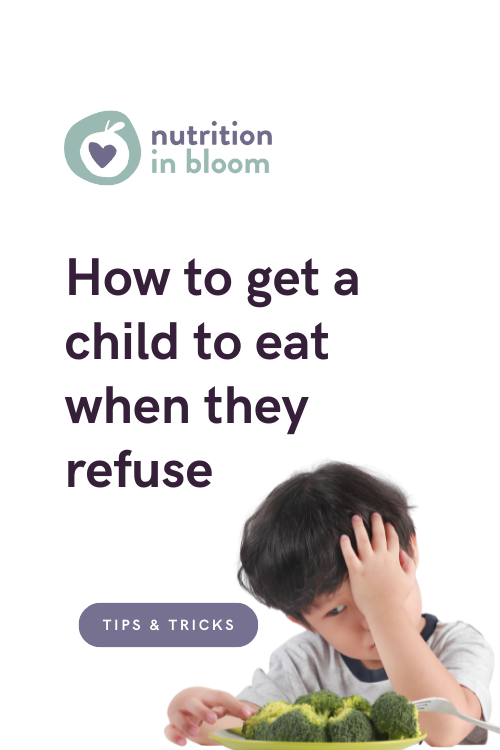How to get a child to eat when they refuse
We’ve all been there. At mealtime you hear from your child...
“YUCK! I’m not eating that!
“You can’t make me eat it!”
Or, maybe your child just refuses to come to the table.
It can be stressful, frustrating, and really even feel scary when your child refuses to eat.
Let’s talk about what may be happening and the 5 simple strategies to get your child to eat when they refuse.
Typical toddler development and picky eating
Before we dive in too far, let’s talk a bit about the why. As babies grow into toddlers they are developing: they are becoming more independent, gaining autonomy and learning they have likes and dislikes. They can become picky eaters.
It’s great from a development standpoint (we want to raise independent kids), but can be really frustrating from a parenting standpoint - when we just want our child to eat.
Some children may also have some other factors at play that may make eating (especially new foods) difficult, that could be related to their sensory systems or developmental challenges.
What does it mean to get your child to eat (reframing this idea)
I want to talk about what it means to get your child to eat, and I want to reframe this idea. The Division of Responsibility, created by dietitian and family therapist Ellyn Satter, is a research based guide on how we can help kids develop a healthy relationship with food.
This guide talks about how parents are responsible for the: what, when and where of feeding, and children are responsible for the how much and whether of eating. What that means is that we can’t “get” our kids to eat.
I want you instead to think about letting your kids eat. You can check out more about the why behind this method in this post. When we think about “letting” we can remind ourselves that it’s not our job to get our kids to eat.
Food refusal may happen, and now, let’s talk about what we can do when our child refuses, or just does not seem interested in eating.
5 simple strategies to get a child to eat when they refuse
1. Don’t put pressure on your child, and don’t punish your child for not eating.
Although it may turn into a power struggle, a child not eating isn’t a reflection on you. How often do your ask your child to, “just take one bite,” only to be met with closed lips - and that they have decided they don’t like the food before even trying it.
When we put pressure on our little ones it backfires. At mealtime, it creates a toddler or child that simply doesn’t want to eat.
2. What does your meal and snack routine look like?
Do you have a routine around meals and snacks? Here’s how it can actually help toddlers and children eat more:
Let’s think of the stomach like a gas tank. If we are constantly topping off the gas tank, we are never allowing it to fully empty, so we can completely fill it up again. The same goes for our stomach.
If we are constantly eating small amounts, we are not allowing our stomach to empty and digest our food so we can feel hungry. When we have a break between meals we allow that food to digest, to maximize our hunger at the next meal or snack, and allow a satisfying amount to be eaten.
Most young children do best with meals and snacks every 2-2.5 hours, while older children do best with meals and snacks every 3-4 hours. But read your child. Some younger children can go longer stretches without food, while some older children need meals and snacks to be closer together.
3. Focus on what your child can DO when it comes to eating, even if they are a picky eater.
It can be easy to think about what our child is not doing: not eating vegetables, refusing to eat, creating a mealtime nightmare.
Can we reframe this? Can we think about what they ARE doing? I want you to think about one food they ARE eating. Let’s say it’s bread. Can you find a new type of bread and offer that at dinner?
Or maybe they like pasta. Can you find a new noodle shape to cook? They are more likely to eat the familiar than something completely brand new.
4. Think about exposure
As a pediatric dietitian, I am always talking with parents about exposure. It’s a huge part of the process in learning to eat new foods.
Your child that may be refusing to eat vegetables is one step closer to eating those vegetables when you expose them (even if they don’t actually eat them). Serve them. You and the rest of the family should enjoy them too!
5. Think about interaction
And while we are talking about exposure, let’s talk about interaction. Do you know what’s just as good as your child eating a vegetable? Licking, touching or smelling that vegetable.
The more a child interacts with new foods, the more likely they are to eventually eat that food. Don’t give up.
Bottom line: let’s get our kids to eat
It can be absolutely normal for our kids to refuse to eat, and just not seem interested in eating. But there are absolutely things we can do to combat this behavior - in a respectful, kind way, without pressure.
We can think about our feeding routine, focus on what they can do, and think about exposure and interaction when it comes to eating.
Although feeding may feel so frustrating, let’s get more joy in mealtimes.
Want to learn more when it comes to creating a happier mealtime? Download my free guide: 4 steps to help your little one try new foods. It contains more simple tips and strategies you can use right now.

